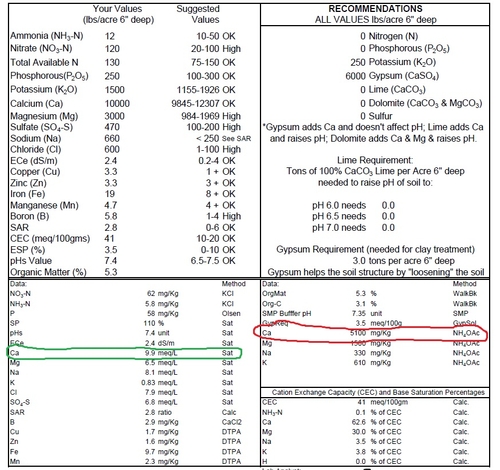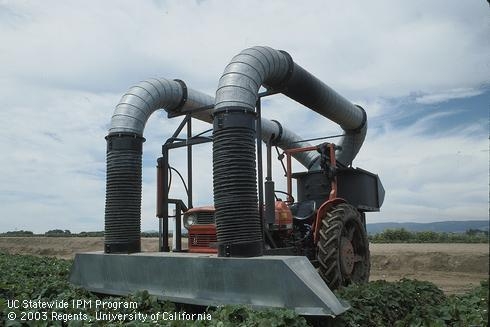Strawberries
Webinar for Organic Blackberry Production
Webinar on Organic Blackberry Production-- March 13
You are invited to take part in a webinar on "Organic Blackberry Production: Tips learned from an ongoing research study", presented by Bernadine Strik and Luis Valenzuela of Oregon State University and David Bryla of the USDA ARS in Corvallis, Oregon. The webinar takes place on March 13, 2014 at 2PM Eastern Time (1PM Central, 12PM Mountain, 11AM Pacific Time). Audience members will be able to type in questions for the speakers. The webinar is free and open to the public, but advance registration is required.
Register now at: https://www1.gotomeeting.com/register/363427577. Visit http://www.extension.org/pages/70279/organic-blackberry-production:-tips-learned-from-an-ongoing-research-study to learn more, including system requirements for participating.
Quick Tip on Interpreting Calcium Results on Soil Analyses
Another short summary from the Fertility Short Course held by Tim Hartz and Stuart Pettigrove at UC Davis this past fall.
Calcium (Ca) has an important role in plant nutrition, but we tend not to pay too much attention to it because rarely is it an issue in berry health on the Central Coast. As outlined further on in this post, it's because we have so much of it already in our soils here.
Crop uptake of calcium is in the range of 100- 300 lb per acre, which means having a soil test like the one below with something around 5100 ppm has a potential supply of 10,200 lbs of Ca per acre (5100 PPM x 2 = 10,200 lbs/A) in the top 6” of soil apparently is well excess of what is needed.
Then again, we know that all the Ca removed in this ammonium acetate (NH4OAc) extraction is not all available to the plant because it can be tied up on soil particles, organic matter, colloids or precipitated out as Ca compounds.
A saturated paste analysis like the one on the left of the soil test below (circled in green) is the way to address what is really available to the plant. Results are most commonly given in meq/l, meaning milliequivalents per liter solution.
To get a feel for the Ca availability that we see on our saturated paste soil results, bear in mind that hydroponic solutions for greenhouse or substrate production, which are formulated for optimum crop growth and production, are 4-8 meq Ca/liter, and comprise 30-50% of the total cation meq. Comparing this ideal formulation with a survey (see link below) of representative crop production soils in coastal and central California which found of average of approximately 6.6 meq/liter Ca (assuming a 5:1 ratio soil solution/saturated paste and equivalent to 660 ppm Ca) and represented 55% of the cation milliequivalents. This amount, roughly calculated out, arrives at 600 lb Ca in soil solution. To reiterate from the above, crop removal is around 100-300 lb per acre, so this gives us a lot of confidence that we really have ample Ca around here for our berry crops.
Thinking through this to its practical application in the field, compared to the large amounts of calcium already available in our soils, fertilizer additions of calcium don't really add that much at all. For example, the “calcium kick” from a fertilizer like CAN-17 (12.3 lb/gal, 8.8 % Ca, so a 3 gal/A application simply adds 3.25 lbs of Ca/A - a mere drop in the pool of 600 lbs already there for the plant) isn't much of a kick at all.
Here is the excellent link discussing calcium availability in coastal and central California soils referred to in this post :
http://www.cdfa.ca.gov/is/docs/04-0701Hartz%2007.pdf

Soil sample from strawberry field taken last year. Potential calcium supply is 5100 ppm on the right and circled in red, and saturated paste, a measure of calcium availability, is 9.9 meq/l, is on the left circled in green.
Giant Lygus Bug Vac
I saw this photo in the UC IPM archives. Since it is a really unusual configuration and the fact that lately bug-vacs have become a bigger part of the lygus management discussion again, I thought this might be something to share with my readers.
To find out more, I contacted Thom Flewell, who wrote this in response:
"I used to have 3 bug vacs with that general configuration. The fans were from plastics manufacturing and were used to move the pellets that formed the feed stock for producing plastics. Mike McCluney made many Bug Vacs using these fans, usually with one fan per bed. They were very heavy, and demanded about 17 horse power per fan. The tractors had barely enough power to operate the fans and move the machinery down the rows. There were two disadvantages with these machines. The size of the fans required mounting them off the back of the tractor. The aspirator head had to be placed forward of the tractor to keep from scaring the lygus and causing them to drop below the effective suction zone of the machine. The problem was with the distance that separated the head and the fan. Vacuum was reduced significantly along the travel from the head to the fan. The second problem was the weight of the machines. It was not uncommon to have a driver let his attention wander and the tractor then wandered too, going from the hard-packed furrow to the soft and soggy bed. When the wheels left the furrow and sunk in the beds, destruction followed and pulling the tractor back up onto the furrow was like trying to pull it from a swamp onto a railroad track.
The greatest advantage to these fans was that nothing that enter the volute exited alive. The fan employed flat impeller blades accounting for their inefficiency. But that same inefficiency meant that air and anything entrained in the air flow probably collided either with the blades or the side of the fan before exiting. Only parts remained. "
Thanks Thom!

Picture of giant bug vac used used some years ago in strawberries.
Understanding Plant Salt Tolerance in Gypsiferous Soils
For those of you who attended Steve Grattan's presentation at UCCE Monterey last week on managing salinity in vegetable production, you may recall he mentioned that strawberries in gypsiferous soils can tolerate a higher EC reading than the salt tolerance guidelines allow. I wasn't quite clear about this, so I emailed about it and his answer concerning this is as follows:
"Crop salt tolerance is based on crops response to the electrical conductivity of the saturated soil paste (ECe). But in actuality, crops respond to the salinity in the soil water. These are different.
The field soil water content for many berries and vegetable crops is slightly above or below the field capacity. This means that about 1/2 of the pore volume in the soil is water and the other half is air. To make a saturated paste, distilled water (pure water without salts) is added to fill the extra pore space. Now if the salts in the soil water are largely sodium and chloride (very soluble), then the ECe would be about half the EC of the soil water in the field...which is what the crop is truly responding to. But if the soil contains a lot of gypsum (CaSO4), then by adding distilled water, more salts will become dissolved so that the ECe would be higher.
As an example, the literature indicates that strawberries can tolerate a maximum ECe of 1 dS/m, beyond which yields decline 33% for every 1 EC unit is increased beyond that. This was based on a chloride dominated water. Therefore, stawberries can tolerate about an EC of 2 in the field water. Gypsum has a maximum solubility of about 20 meq/l which is an EC of about 2 dS/m but this is just a generalization and can vary depending on soil chemistry. But for simplicity, if the salts were all gypsum (no sodium chloride) than if the soils had excess gypsum, the EC of the field water would be about 2 (no yield reduction). But to make a saturated paste, distilled water is added and more gypsum is dissolved so the resulting ECe is not 1 but remains at 2. Therefore an ECe of 2 dS/m is not growth limiting in this case.
The rule of thumb is that plants can typically tolerate a 1-2.5 dS/m higher ECe than the salt tolerance guidelines indicate in gypsiferous soils because of this relationship."
Powerpoint Presentations from 2014 Annual Strawberry Meeting Online
The powerpoint presentations from today's 2014 Annual Strawberry Meeting are now for the most part online. Thanks to all the presenters for making this such a great meeting:
http://ucanr.edu/2014_annual_strawberry_production_ppt

